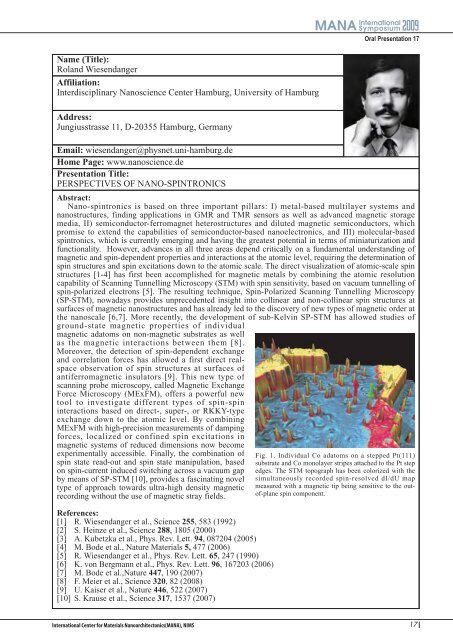Abstract Download (8.38MB)
Abstract Download (8.38MB)
Abstract Download (8.38MB)
Create successful ePaper yourself
Turn your PDF publications into a flip-book with our unique Google optimized e-Paper software.
Name (Title):<br />
Roland Wiesendanger<br />
Affiliation:<br />
Interdisciplinary Nanoscience Center Hamburg, University of Hamburg<br />
Address:<br />
Jungiusstrasse 11, D-20355 Hamburg, Germany<br />
Email: wiesendanger@physnet.uni-hamburg.de<br />
Home Page: www.nanoscience.de<br />
Presentation Title:<br />
PERSPECTIVES OF NANO-SPINTRONICS<br />
<strong>Abstract</strong>:<br />
Nano-spintronics is based on three important pillars: I) metal-based multilayer systems and<br />
nanostructures, finding applications in GMR and TMR sensors as well as advanced magnetic storage<br />
media, II) semiconductor-ferromagnet heterostructures and diluted magnetic semiconductors, which<br />
promise to extend the capabilities of semiconductor-based nanoelectronics, and III) molecular-based<br />
spintronics, which is currently emerging and having the greatest potential in terms of miniaturization and<br />
functionality. However, advances in all three areas depend critically on a fundamental understanding of<br />
magnetic and spin-dependent properties and interactions at the atomic level, requiring the determination of<br />
spin structures and spin excitations down to the atomic scale. The direct visualization of atomic-scale spin<br />
structures [1-4] has first been accomplished for magnetic metals by combining the atomic resolution<br />
capability of Scanning Tunnelling Microscopy (STM) with spin sensitivity, based on vacuum tunnelling of<br />
spin-polarized electrons [5]. The resulting technique, Spin-Polarized Scanning Tunnelling Microscopy<br />
(SP-STM), nowadays provides unprecedented insight into collinear and non-collinear spin structures at<br />
surfaces of magnetic nanostructures and has already led to the discovery of new types of magnetic order at<br />
the nanoscale [6,7]. More recently, the development of sub-Kelvin SP-STM has allowed studies of<br />
ground-state magnetic properties of individual<br />
magnetic adatoms on non-magnetic substrates as well<br />
as the magnetic interactions between them [8].<br />
Moreover, the detection of spin-dependent exchange<br />
and correlation forces has allowed a first direct realspace<br />
observation of spin structures at surfaces of<br />
antiferromagnetic insulators [9]. This new type of<br />
scanning probe microscopy, called Magnetic Exchange<br />
Force Microscopy (MExFM), offers a powerful new<br />
tool to investigate different types of spin-spin<br />
interactions based on direct-, super-, or RKKY-type<br />
exchange down to the atomic level. By combining<br />
MExFM with high-precision measurements of damping<br />
forces, localized or confined spin excitations in<br />
magnetic systems of reduced dimensions now become<br />
experimentally accessible. Finally, the combination of<br />
spin state read-out and spin state manipulation, based<br />
on spin-current induced switching across a vacuum gap<br />
by means of SP-STM [10], provides a fascinating novel<br />
type of approach towards ultra-high density magnetic<br />
recording without the use of magnetic stray fields.<br />
References:<br />
[1] R. Wiesendanger et al., Science 255, 583 (1992)<br />
[2] S. Heinze et al., Science 288, 1805 (2000)<br />
[3] A. Kubetzka et al., Phys. Rev. Lett. 94, 087204 (2005)<br />
[4] M. Bode et al., Nature Materials 5, 477 (2006)<br />
[5] R. Wiesendanger et al., Phys. Rev. Lett. 65, 247 (1990)<br />
[6] K. von Bergmann et al., Phys. Rev. Lett. 96, 167203 (2006)<br />
[7] M. Bode et al.,Nature 447, 190 (2007)<br />
[8] F. Meier et al., Science 320, 82 (2008)<br />
[9] U. Kaiser et al., Nature 446, 522 (2007)<br />
[10] S. Krause et al., Science 317, 1537 (2007)<br />
Oral Presentation 17<br />
Fig. 1. Individual Co adatoms on a stepped Pt(111)<br />
substrate and Co monolayer stripes attached to the Pt step<br />
edges. The STM topograph has been colorized with the<br />
simultaneously recorded spin-resolved dI/dU map<br />
measured with a magnetic tip being sensitive to the outof-plane<br />
spin component.<br />
17















